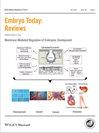Nicola C. Foster, James R. Henstock, Yvonne Reinwald, Alicia J. El Haj
下载PDF
{"title":"动态三维培养:软骨形成和软骨内成骨模型","authors":"Nicola C. Foster, James R. Henstock, Yvonne Reinwald, Alicia J. El Haj","doi":"10.1002/bdrc.21088","DOIUrl":null,"url":null,"abstract":"<p>The formation of cartilage from stem cells during development is a complex process which is regulated by both local growth factors and biomechanical cues, and results in the differentiation of chondrocytes into a range of subtypes in specific regions of the tissue. In fetal development cartilage also acts as a precursor scaffold for many bones, and mineralization of this cartilaginous bone precursor occurs through the process of endochondral ossification. In the endochondral formation of bones during fetal development the interplay between cell signalling, growth factors, and biomechanics regulates the formation of load bearing bone, in addition to the joint capsule containing articular cartilage and synovium, generating complex, functional joints from a single precursor anlagen. These joint tissues are subsequently prone to degeneration in adult life and have poor regenerative capabilities, and so understanding how they are created during development may provide useful insights into therapies for diseases, such as osteoarthritis, and restoring bone and cartilage lost in adulthood. Of particular interest is how these tissues regenerate in the mechanically dynamic environment of a living joint, and so experiments performed using 3D models of cartilage development and endochondral ossification are proving insightful. In this review, we discuss some of the interesting models of cartilage development, such as the chick femur which can be observed in ovo, or isolated at a specific developmental stage and cultured organotypically in vitro. Biomaterial and hydrogel-based strategies which have emerged from regenerative medicine are also covered, allowing researchers to make informed choices on the characteristics of the materials used for both original research and clinical translation. In all of these models, we illustrate the essential importance of mechanical forces and mechanotransduction as a regulator of cell behavior and ultimate structural function in cartilage. Birth Defects Research (Part C) 105:19–33, 2015. © 2015 Wiley Periodicals, Inc.</p>","PeriodicalId":55352,"journal":{"name":"Birth Defects Research Part C-Embryo Today-Reviews","volume":"105 1","pages":"19-33"},"PeriodicalIF":0.0000,"publicationDate":"2015-03-16","publicationTypes":"Journal Article","fieldsOfStudy":null,"isOpenAccess":false,"openAccessPdf":"https://sci-hub-pdf.com/10.1002/bdrc.21088","citationCount":"31","resultStr":"{\"title\":\"Dynamic 3D culture: Models of chondrogenesis and endochondral ossification\",\"authors\":\"Nicola C. Foster, James R. Henstock, Yvonne Reinwald, Alicia J. El Haj\",\"doi\":\"10.1002/bdrc.21088\",\"DOIUrl\":null,\"url\":null,\"abstract\":\"<p>The formation of cartilage from stem cells during development is a complex process which is regulated by both local growth factors and biomechanical cues, and results in the differentiation of chondrocytes into a range of subtypes in specific regions of the tissue. In fetal development cartilage also acts as a precursor scaffold for many bones, and mineralization of this cartilaginous bone precursor occurs through the process of endochondral ossification. In the endochondral formation of bones during fetal development the interplay between cell signalling, growth factors, and biomechanics regulates the formation of load bearing bone, in addition to the joint capsule containing articular cartilage and synovium, generating complex, functional joints from a single precursor anlagen. These joint tissues are subsequently prone to degeneration in adult life and have poor regenerative capabilities, and so understanding how they are created during development may provide useful insights into therapies for diseases, such as osteoarthritis, and restoring bone and cartilage lost in adulthood. Of particular interest is how these tissues regenerate in the mechanically dynamic environment of a living joint, and so experiments performed using 3D models of cartilage development and endochondral ossification are proving insightful. In this review, we discuss some of the interesting models of cartilage development, such as the chick femur which can be observed in ovo, or isolated at a specific developmental stage and cultured organotypically in vitro. Biomaterial and hydrogel-based strategies which have emerged from regenerative medicine are also covered, allowing researchers to make informed choices on the characteristics of the materials used for both original research and clinical translation. In all of these models, we illustrate the essential importance of mechanical forces and mechanotransduction as a regulator of cell behavior and ultimate structural function in cartilage. Birth Defects Research (Part C) 105:19–33, 2015. © 2015 Wiley Periodicals, Inc.</p>\",\"PeriodicalId\":55352,\"journal\":{\"name\":\"Birth Defects Research Part C-Embryo Today-Reviews\",\"volume\":\"105 1\",\"pages\":\"19-33\"},\"PeriodicalIF\":0.0000,\"publicationDate\":\"2015-03-16\",\"publicationTypes\":\"Journal Article\",\"fieldsOfStudy\":null,\"isOpenAccess\":false,\"openAccessPdf\":\"https://sci-hub-pdf.com/10.1002/bdrc.21088\",\"citationCount\":\"31\",\"resultStr\":null,\"platform\":\"Semanticscholar\",\"paperid\":null,\"PeriodicalName\":\"Birth Defects Research Part C-Embryo Today-Reviews\",\"FirstCategoryId\":\"1085\",\"ListUrlMain\":\"https://onlinelibrary.wiley.com/doi/10.1002/bdrc.21088\",\"RegionNum\":0,\"RegionCategory\":null,\"ArticlePicture\":[],\"TitleCN\":null,\"AbstractTextCN\":null,\"PMCID\":null,\"EPubDate\":\"\",\"PubModel\":\"\",\"JCR\":\"Q\",\"JCRName\":\"Medicine\",\"Score\":null,\"Total\":0}","platform":"Semanticscholar","paperid":null,"PeriodicalName":"Birth Defects Research Part C-Embryo Today-Reviews","FirstCategoryId":"1085","ListUrlMain":"https://onlinelibrary.wiley.com/doi/10.1002/bdrc.21088","RegionNum":0,"RegionCategory":null,"ArticlePicture":[],"TitleCN":null,"AbstractTextCN":null,"PMCID":null,"EPubDate":"","PubModel":"","JCR":"Q","JCRName":"Medicine","Score":null,"Total":0}
引用次数: 31
引用
批量引用

 求助内容:
求助内容: 应助结果提醒方式:
应助结果提醒方式:


